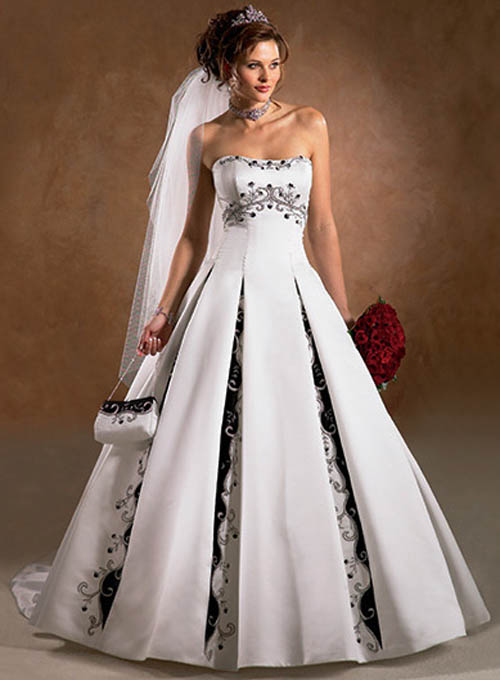Source (Google.com.pk)
Bridal Dresses Pictures Biography












Bridal Dresses Pictures Biography
Here's the deal: Your wedding dress will be photographed and documented more than any other article of clothing you own, so it's important to choose a wedding gown you love! But when you first start shopping for wedding dresses, the seemingly limitless options can be overwhelming. Fortunately, we've found a way to make shopping for wedding gowns as painless as possible. Start by breaking down our galleries of over 3,000 bridal gowns by wedding dress designer, wedding gown style, and by dress price range. Looking for a higher-end, A-line wedding dress with a sweetheart neckline? No problem-o. Our wedding gown search tool will help you do this. As you find wedding dresses you like, save the images to your Knot Notebook and the Wedding Look Book on your Knot Bio. Once you've found a few wedding gowns you like (or at least have an idea of the wedding dress style you're looking for), it's time to start shopping! Use our local resource guides to find bridal salons and wedding gown shops near you. Bring the pictures you've found to the stores to see if they carry those dresses, but don't be afraid to try on other styles. You just might find that the wedding dress you didn't expect to like looks fabulous on you. After you've narrowed down your top two or three bridal gowns, invite your mother, best friend, or a close relative whose opinion you trust to come to the store and help you make the final decision.
The indigenous peoples of the Americas have varying traditions related to weddings and thus wedding dresses. A Hopi bride traditionally would have her garments woven by the groom and any men in the village who wished to participate. The garments consisted of a large belt, two all-white wedding robes, a white wedding robe with red stripes at top and bottom, white buckskin leggings and moccasins, a string for tying the hair, and a reed mat in which to wrap the outfit. This outfit also would serve as a shroud, since these garments would be necessary for the trip through the underworld.
A Pueblo bride wore a cotton garment tied above the right shoulder, secured with a belt around the waist.
In the traditions of the Delaware, a bride would wear a knee-length skirt of deerskin and a band of wampum beads around her forehead. Except for fine beads or shell necklaces, the body would be bare from the waist up. If it were a winter wedding, she would wear deerskin leggings and moccasins and a robe of turkey feathers. Her face would be painted with white, red and yellow clay.
The tribes of Northern California (which include the Klamath, the Modoc and the Yurok) had a traditional bridal dress woven in symbolic colors: white for the east, blue for the south, yellow (orange) for the west; and black for the north. Turquoise and silver jewelry were worn by both the bride and the groom in addition to a silver concho belt. Jewelry was considered a shield against evils including hunger, poverty and bad luck.
The indigenous peoples of the Americas have varying traditions related to weddings and thus wedding dresses. A Hopi bride traditionally would have her garments woven by the groom and any men in the village who wished to participate. The garments consisted of a large belt, two all-white wedding robes, a white wedding robe with red stripes at top and bottom, white buckskin leggings and moccasins, a string for tying the hair, and a reed mat in which to wrap the outfit. This outfit also would serve as a shroud, since these garments would be necessary for the trip through the underworld.
A Pueblo bride wore a cotton garment tied above the right shoulder, secured with a belt around the waist.
In the traditions of the Delaware, a bride would wear a knee-length skirt of deerskin and a band of wampum beads around her forehead. Except for fine beads or shell necklaces, the body would be bare from the waist up. If it were a winter wedding, she would wear deerskin leggings and moccasins and a robe of turkey feathers. Her face would be painted with white, red and yellow clay.
The tribes of Northern California (which include the Klamath, the Modoc and the Yurok) had a traditional bridal dress woven in symbolic colors: white for the east, blue for the south, yellow (orange) for the west; and black for the north. Turquoise and silver jewelry were worn by both the bride and the groom in addition to a silver concho belt. Jewelry was considered a shield against evils including hunger, poverty and bad luck.
Bridal Dresses Pictures

Bridal Dresses Pictures

Bridal Dresses Pictures

Bridal Dresses Pictures

Bridal Dresses Pictures

Bridal Dresses Pictures

Bridal Dresses Pictures

Bridal Dresses Pictures

Bridal Dresses Pictures

Bridal Dresses Pictures

Bridal Dresses Pictures

Bridal Dresses Pictures

Bridal Dresses Pictures
No comments:
Post a Comment